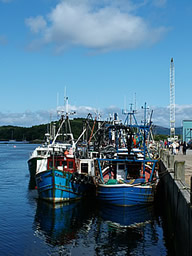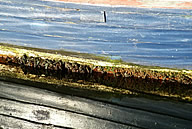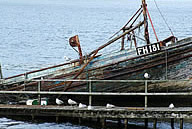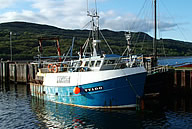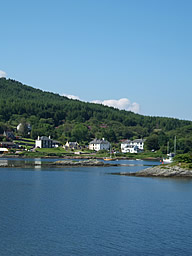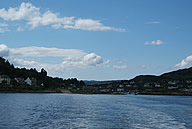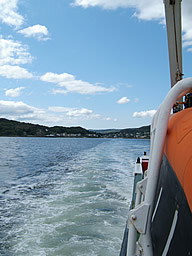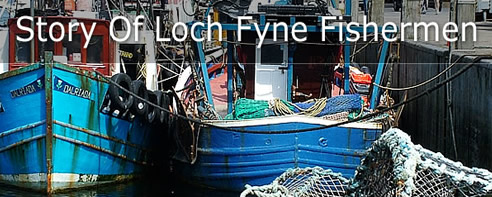
Story Of The Fishermen
Tarbert Loch Fyne Fishing History
It is seldom that anyone can walk along Tarbert quay without seeing something of interest. There are nearly always fishing boats or yachts about, perhaps there is someone mending a net, weighing or selling fish at the auction or loading up a lorry with the day's catch or some suchlike scene.
Of the fishing boats, the larger ones usually take part in the herring fishing and are lying at the quay during the day, after being out at sea the previous night. They have come back to port in the early morning, when their crews have discharged their catches and seen them auctioned, and are nw at home having their rest in preparation for the next night's work. Herring are usually easier to catch at night so these boats go to sea in search of fish about five or six o'clock in the summer and return again with their catches for the herring sale, which is generally about six or seven o'clock in the morning.
These boats all use the pair trawl method of fishing nowadays. The net is towed between two boats and can be lowered or lifted by altering the amount of warp between the net and the boats, according to the depth that the herring show up on the echosounders.
Almost everyone knows that there are restrictions as to the amount of herring that can be caught.
Every boat is allocated a "Quota" of herring and this is based on the number of crew which the boat carries.
We are all conscious of "Conservation" but this is not a new idea. In 1883 a group of Tarbert fishermen became so anxious about overfishing and the fact their Sabbath was being interfered with, that they travelled to London and lobbied their MP. As a result of this journey south a law was passed, making the catching of herring in the Firth of Clyde illegal between sun-up on Saturday and sunset on Monday. This law was in force until the law relating to Restrictive Practices came into force. If by chance a skipper gets in among fish and catches more than his quota in his net, he will call up one of his chums on the radio and offer the surplus to him.
The smaller boats, prawnboats as we call them, do their work during the daylight hours and land their catches in the evening. There is always plenty of activity when they come in as prawns are sold by the stone, and so every box has to be tipped and weighed.
When this has been done, the Port Officer weighs one pound of prawns out of each box and then puts a ticket stating the count of this pound of prawns into the box, so declaring the quality for the buyers to bid on. Any white fish which have been caught along with the prawns are also sold at this time.
A gannet, while seeking herring, will fly at a fair height and, as herring may be swimming perhaps 30 to 50 feet beneath the surface of the sea and he has to get down to that depth to catch his prey, he has to make a neat, clean, dive. After a while a fisherman gets to know whether a bird has dived for herring, by going cleanly into the water, or has got himself a mackerel or some small fish by just taking a shallow dive into the sea.
The sighting of a whale, or Muc Mhara (from the Gaelic - a sea pig), would always tell the old fishermen that there were herring in the area, for being such a large animal it would seldom be far away from a food supply.
The methods the men used at the time for pinpointing fish were by watching for gannets diving on fish, a sighting of a whale. seeing plankton on the sea, herring jumping and generally being wise to the ways of the herring.
Basking sharks, too, always show where there is plankton but a brush with a basking shark nearly always means a torn net.
Before 1830, when the idea of ringnetting was first conceived, all herring were caught by the driftnet method. The nets were strung out over the sea, where the fishermen had seen sign of fish, and were hauled back after a while, when it was hoped that some herring had become enmeshed in them.
Herring have a beautiful habit of jumping out of the sea at gloaming and again at daybreak. On a quiet evening or morning it is possible to hear and sometimes see this strange phenomenon, and the fishermen were not slow to shoot their nets in the area where they had been on the alert and seen or heard this happening.
On a warm summer's evening plankton can sometimes be seen. The tides throw up this fishfood, and it can be seen perhaps as a red cloud or all. Before thje scientists ever thought of giving the sea-lifegiving-food latin names, the old fishermen knew that there was a red "stuff\ which appeared on the sea on warm afternoons and they discovered that this was what herring fed on, so they would shoot their nets where they saw this "red eye" or "suil dhearg", and, that is they looked into the surface of the water, almost on to the sun's reflection, they could see a pinprick bubbling there and they called it "black eye" or "suil dhubh". There were nearly always herring to be had where this was seen.
Being a fsherman at that time entailed each man having his own gear and, perhaps, having a share in the boat in which he worked. Nets were hand braided and it served a man well to have daughters as well as a wife, for it was one or a woman's chores to braid a certain amount of net so that her man could have the gear with which to fish during the season. When net looms came along this chore became unnecessary. After the net had been completed it had to be tanned to combat rot. This was done by boiling it in a solution of "cutch", which was a mixture of leaves and resin that came from Borneo.
When the boat, or skiff as it was called, went to sea and a catch was taken and marketed, the money for the catch was divided equally between the owners of the boat, the net woners and the men whoe crewed the boat. There was usually four men to a crew, including the skipper.
Somewhere about 1830, some fishermen had the idea that there must be a quicker way of catching herring and, one day, surrounded a shoal of herring in a small bay and waited till the tide went out and so loaded the trapped herring into their boat. Gradually a method was developed where the net was shot and then hauled back into the boat. Next the two-boat method came into practice in which a boat took a hold of each end of the net and towed it into a ring as they met together.
Between 1830 and 1867 there were troubled times in Tarbert, for the method of ringnetting which had been devised was deemed to be illegall in 1851. Even as far back as then, there were people who could see that this was a deadly method of catching herring, compared to the old method, and they feared for the stocks.
However, Tarbert men and women were not to be put off, and for twenty-six years they waged a constant battle with the authorities. Many tales are told of the means used to hide their nets from the fishery officers, and several people were jailed and one man was shot and killed before the law was passed legalising the ringnet in 1867.
Around sixty years ago it was decided to install engines in the boats, to save labour of rowing the skiffs, along with their catches, to market. This proved to be an excellent idea and so the fishermen graduated to bigger boats with bigger nets. They had started off with boats approximately twenty-five feet in length with eight feet of beam and, with the advent of engines, they now reached thirty-five to forty feet in length and some ten to twelve feet of beam, so they were becoming too heavy to haul the gear to them.
Then about fifty years ago a Campbeltown man by the name of Robertson had the idea that the old skiffs with their overstern rudders were unhandy, so he had two boats built at St. Monance, in Fife, with canoe sterns, and from there developed the boats we have today. These boats were fifty feet in length and had wheelhouses. They were excellent for getting herring to market in poor weather but were extremely difficult to work in breezy conditions because of their weight.
A winch was invented next, and although not all the work was taken out of the handling the gear, it was tremendous help to have the footrope taken in quickly with the help of the winch. The essential part of catching herring with the ring net was to get the footrope, or sole, hauled in as quickly as possible thus completeing the trap around the herring.
Methods of finding and handling herring developed further with the bigger boats. It became possible to steam about looking for the fish in the sea at night. From April until October, except on clear moonlit nights, a phosphorescence comes on the water, and during this time it is possible to determine whether the schoal is herring or mackerel by the antics of the particular shoal. Each fish, when disturbed at night, leaves a flare path of white as it churns the phosphorescence in its efforts to swim away from the boat and consequently a shoal will almost turn the water white for a second ot two in the attempt to escape.
Another idea was brought from Norway and proved invaluable on moonlit nights and during daylight hours and also on winter nights when there was no phosphorescence. A five pound lead weight was attached to a twenty or thirty fathom length of piano wire which was trailed over the stern as the boat steamed along dead slow. If the crewman holding onto the wire lead could feel a series of taps on the wire, he would report this to the Skipper, who would decide whether or not to shoot the net. This also proved to be the first method of deciding whether the ground was suitable for shooting a net, as by letting the lead trail along the seabed it was very obvious to the man at the wire if the ground was rocky or sandy.
When first herring were caught in ringnets, they had to be bailed out of the net and into the hold by leaning over the boat's side with a basket and lifting them up over the gunwale.
This was fine for a few years and then someone had the idea that it would be handy to put a pole into the basket and so, for many more years, what was known as a "stick basket" was used for emptying the nets and loading the boat.
After the coming off the winch another idea was introduced from Norway wherby a derrick was mounted near the middle of the boat and rigged so that it could be swung out over the boat's side in use and thus lift the tail-end of a sock of netting attached to an iron ring about three feet in diameter. The ring, replacing the basket on the end of the "stick", and consequently the sock of netting, was drawn through the bag of herring by the derrick winch and the whole thing lifetd to empty the fish from the sock into the hold. Some twenty baskets at a time, perhaps fifteen hundredweight of herring, was about the average amount of fish taken aboard the boat each time the ring was drawn through the bag. This was known as brailing.
After the 1939-45 war a new dimension came into the industry. Grants and loans were made available to the men returned from the war. A bigger type of boat was the order of the day, so that it would be possible to follow the herring seasons from the Isle of Man in summer to Noth-east England in autumn and the Minch in winter. Boats around fifty-five feet in length and seventeen feet in beam proved ideal and then echo-sounders came along, followed by radio. Echo-sounders saved time as the boats could range over a much wider area as it was now possible to search for herring while steaming at full speed, and radio permitted the skippers to know what was happening on other fishing grounds.
This was pretty well the situation until 1968, with an occasional new boat coming along, nearly always bigger and more powerful, for the Minch fishing became a main winter ground from about 1952 until about 1965. The bigger boats were more able to make the passage from the Outer Isles to Mallaig and Oban and could carry more herring when the chance was to be had.
In 1968 the pair trawl came along and this again brought changes. First of all, boats had to be equipped with a trawl winch which could wind up and hold the amount of wire warp necessary to operate the gear, and then they had to have ever more powerful engines installed. Our local boats are all middle-of-the-road trawlers and have engines ranging from 200 to 300 horse power.
Fishermen are always on the lookout for equipment which will simplify the handling of gear. The next help in this direction came with the power-block. This piece of apparatus is installed behind the wheelhouse of the boat and is mounted on a swivelling crane. It consists of a hydraulically powered rubber drum with a "V" in the middle. The principle on which it works is that when the crewmen want to pull in the net, all they have to do is pull the net, which has previously been fed into the block and then lifted into the hauling position, down into the "V" of the block when it will haul around the rotating block by the friction of the net on the rubber. To stop hauling all they have to do is to stop pulling. Once the tail-end of the net is reached, and hopefully the herring, the block can be swivelled round and the bag placed along the boat's side in preparation for lifting the herring aboard by derrick.
About 1954 there came a time of scarcity of herring on the Clyde fisheries and some men were not prepared to sit back and wait for them to come along. It was then that the smaller forty foot vessel was introduced. The law at that time allowed boats of forty feet and under to operate seine nets inside the three mile limit. A few of these boats are still to be seen at the quayside. Each new boat that came along was an improvement on the original and gradually they reached the present-day model. The last of these boats was built of steel and delivered in 1968.
Most mornings, fishermen can be seen working with their nets. If a net has been torn during a night's work it has to be hauled onto the quay where it can be mended. This is a skilled job and takes some time to leanr. Nets are supplied by a few specialist firms and they make up their own particular nets to their own pattern, therefore men must learn the pattern of the net they are using. sometimes nets are torn when a skipper sees a shoal of fish close to a rocky piece of ground and makes a mistake regarding tides or warp length in his calculations to try and catch the fish. Sometimes a net may be shot foul and tear itself shilst it is being towed and occasionally a huge basking shark will tear it, through inadvertently getting caught up in the moving net.
The herring nets take in an area of 130 by 50 feet when being towed, so you can see that it is quite a difficult task to be selecive in the use of a tool of this size.
Prawn boats can usually be seen on Friday mornings sorting out their gear. These men generally work from Monday to Thursday as processors find it impossible to get labour to handle their supplies at week-ends and so the working week is shortened to four days, but the men get round about this by working where possible a twenty hour day.
Prawn nets are constantly in need of repair and renovation as they are used to dig the prawns out of the mud and, usually, the best quality prawns are to be had as close to the rocky bottoms as it is possible to get. Sometimes a set of wheels, called bobbins, is used to wheel the nest over some of the rocky places to try to catch better prawns.
Another piece of equipment which can be sen around the quayis the clam dredge. This item is triangular shaped and has a bag compromised of rings about 3 & 1/2 inches diameter welded together. These dredges are shackled to metal bars about twelve feet long and six inches in diameter.
Clams are usually to be found on rocky bottoms and these dredges and bars have to be as strong as it is possible to make them, in order to withstand the use, or abuse, the skipper has to give them to catch clams. Most of the clams or escallops are caught, nowadays, between the Mull of Kintyre and Skye, so its is seldom that clam boats are at home during the year, preferring to operate from Crinan or Oban and the crews travel home by car at weekends.
Many people ask about the square in the middle of the harbour. This is known locally as "The Beilding". It is built of roock and its purpose was to help sailing boats, before the days of steam, to get alongside the quay and turn them round about when they were ready to leave. You will have noticed that Tarbert Harbour has a narrow entrance and consequently it must have been difficult for sailing vessels to enter the harbour with westerly winds and to get alongside. To help in this operation a capstan was put on the Beilding and a line was taken to any sailing vessel and by it the vessel was hauled up to its berth and if necessary it could be canted when ready to sail. These old sailing vessels used to come to Tarbert to transport cured herring away as well as bringing in coal and supplies for the surrounding areas.
The Beilding and the rest of the upper harbour breast wall is beautifully built of stone which was quarried behind the high beilding at the far end of the quay. You will notice that there is no cement holding the stones together, a tribute to the builders who put up the wall about a hundred and sixty years ago.
A pier was leter constructed outside the harbour where passenger steamers from Glasgow made their daily calls with passengers and mail and provided a link with Islay, Jura and Gigha and even Colonsey. At the farthest end of Tarbert it was attempted to build another pier but unfortunately this was swept away by a gale before it could be completed. This ruined pier is locally called "The Concrete" and a very pleasat walk can be had along the harbour road leading down to this point.
Many yacht owners find Tarbert an excellent stopping-off place. The beautiful natural harbour provides safe anchorage and the shops and hotels accommodate their creature comforts. The relationship between yachtsmen and fishermen is usually very good, although at busy landing times and in breezy weather, when small yachts berth alongside the quay, fishing skippers are particularly anxious that they do not damage the smaller boats, although it is impossible to avoid an occasional small bump. There are many small yachts around these days built with glass fibre. They seem to suit most people's pockets nowadays as they require relatively little maintenance. There seems to be a return to sail amongst yachtsmen, so perhaps a visit to the local sailmaker is a must for them. The boatyard too, provides an excellent service, as it has done for many years. Occasionally we have a visit from some of the older, pre-war, yachts and some of the older fishermen crewed professionally on the yachts and took great pride in their work. At times when herring were scarce, it helped to balance the budget if one or more fishermen from a family took a berth as a yachthand for the season.
Tarbert Loch Fyne - The Story of the Fishermen by Ronnie Johnson (1980)
About The Author
Ronnie Johnson was born and brought up in Tarbert, and educated in tarbert School. On leaving school in 1945 he joined the crew of a Loch Fyne Skiff, Silver Spray. He went on from there to learn his trade as a herring fisherman under several skippers. He also did a couple of seasons as a professional yachthand, and another hunting basking sharks up the entire West Coast of Scotland. His National Service was spent in the Royal Navy.
He bacame a skipper in his own right in 1959 and owned three boats until he retired for health reasons in 1978.
This is the finest factual story of Tarbert and its fishing past to be found today. With excellent drawings accompanying the factual text by Ann Thomas, a well known and respected local artist, this book is a captivating read and the book is available to read from Tarbert Library.
